PERIOD POVERTY
Informational Article by Veda Baliga

Nearly 1 in 10 people worldwide struggle with period poverty, lacking access to necessary menstrual products, hygiene facilities, and education to manage their periods with dignity. This basic human need remains a silent crisis. Young girls, especially those going through their periods, shouldn’t have to worry that menstruation will become an obstacle to human potential. If you are unfamiliar with the term, ‘period poverty’ refers to the lack of access to affordable menstrual products, hygiene facilities, and education related to menstruation, and affects as many as 500 million people across the globe.. As we know, menstruation will not stop because of other world events, disasters, or wars. Yet, millions of individuals continue to face barriers in managing their periods due to inadequate access to menstrual products and hygiene facilities. Period poverty affects both low and high economic classes globally, but it hits lower-income families the hardest.
What causes period poverty at all? The main reason is economic constraints. Many individuals cannot afford menstrual products due to financial limitations. This leads to the use of unhygienic materials, causing infections and other health risks. Many also point to the Pink Tax – a phenomenon where consumer products targeted and advertised to women are, at times, more expensive than comparable products marketed to men. This includes a variety of products such as soaps, lotions, razor blades, and deodorants. In poor rural areas, many schools and work facilities are unable to buy basic needs such as private toilets, which keeps many girls away from school and women away from work during their period.
The second biggest reason is inadequate education about menstrual health. This lack of knowledge leads to improper menstrual management, reinforces negative perceptions, and sustains period poverty. Period Poverty is perpetuated by stigma and the lack of information and education. Many girls and young women lack awareness, leading to unpreparedness when they get their periods. Living in conflict-affected areas or in the aftermath of natural disasters makes it more difficult for people to manage their periods.
There is an enormous amount of health impacts that come hand in hand with period poverty. This might include rashes, infections, and more severe reproductive health issues. For example, prolonged use of menstrual products increases the risk of diseases such as urinary tract infections. In countries that do not have solutions to these problems, women even tend to choose pregnancy to avoid menstruation because they cannot afford to buy such products. Furthermore, girls who do not receive period products face countless mental health conditions, such as stress/anxiety, depression, isolation, and emotional distress. Much of the reason this public health crisis is yet to be acknowledged is largely due to stigma. Often, stigma associates menstruation as “disgusting” and “impure” instead of recognizing it as biologically healthy and normal. Period poverty also sets educational barriers. Female students and even staff suffer from discomfort in school, leading to a lack of focus on academics and work. Not having access to proper menstrual products can also be dehumanizing. Individuals might feel ashamed of their bodies, eroding their sense of dignity and self-worth.
So, how can we put a stop to period poverty? The solution lies in increasing access to menstrual products, breaking the stigma, and ensuring that everyone has the resources they need to manage their periods with dignity. There are many ways you can get involved and make a difference to help end period poverty, such as choosing menstruation products from brands that support ending period poverty, attending marches and events, signing petitions, donating period products, and even educating yourself on the issues and listening to other stories and experiences. When possible,, many advocate for laws that mandate free menstrual products in public institutions such as schools, shelters, etc. For instance, at least 12 US states and the District of Columbia provide free menstrual products in schools. It’s also possible to work with local organizations to distribute menstrual products to underserved communities. In a technological world, just one blog or post addressing period poverty fosters a broader understanding and encourages collective action.
In the journey against period poverty, change is not only necessary but urgent. By addressing the root causes, advocating for policy changes, and breaking the stigma surrounding menstruation, we can ensure that access to menstrual products becomes a basic human right, not a privilege. It is time for us to take action, because no girl or woman should ever have to choose between dignity and health.
